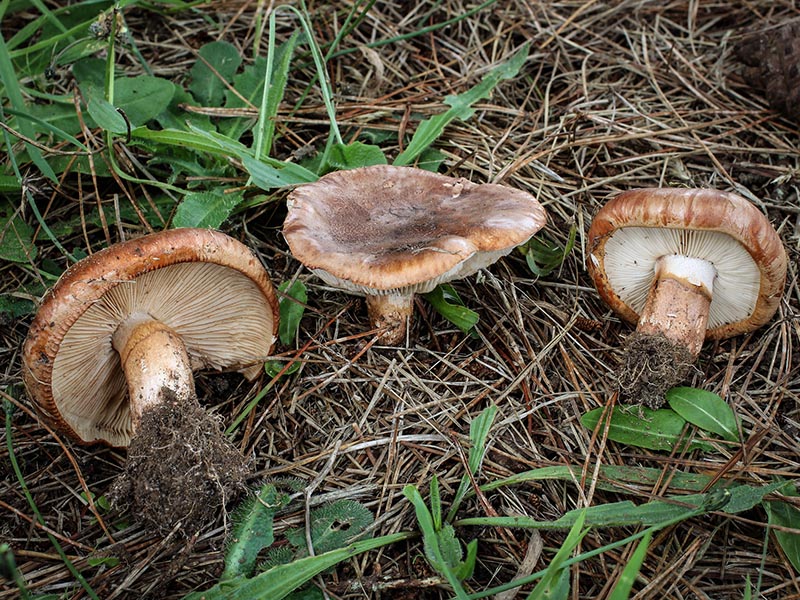Tricholoma fracticum
Feddes repert. 95(9-10): 700. 1984
Common Name: none
-
Pileus
Cap 5-10 cm broad, convex, expanding to nearly plane, in age the disc sometimes depressed with an uplifted margin; margin inrolled, often wavy, becoming decurved, faintly to not striate, rarely conspicuously striate; surface viscid when moist with appressed, radial fibrils, dark red-brown to dull orange-brown, the margin slightly lighter; flesh thick, firm, white, unchanging; odor, mild or faintly of cucumbers; taste, bitter.
-
Lamellae
Gills notched to subdecurrent, close, moderately broad, pallid becoming dull-buff, the edges often discoloring brown in age.
-
Stipe
Stipe 3-8 cm tall, 1.5-2.5 cm thick, solid, round, equal to tapering to a narrowed base; surface cream-buff at the apex, pruinose to slightly fibrillose-striate; below the annulus scattered dingy-brown fibrils or minute scales over a cream-buff ground color, darkening overall in age; veil of glutinous fibrils leaving scattered remnants in a medial to superior zone, the lower margin of which defined by a thin brown line.
-
Spores
Spores 5.5-7.5 x 4-5.5 µm, elliptical, smooth, non-amyloid; spore print white. According to Shanks, basidia mostly 2-spored.
-
Habitat
Gregarious, often clustered, in conifer woods; fruiting from late fall to mid-winter.
-
Edibility
Inedible, bitter.
-
Comments
Tricholoma fracticum closely resembles T. muricatum (formerly known locally as T. pessundatum). Both species have viscid, reddish-brown caps and are found under pines, particularly Monterey pine (Pinus radiata) in our area. Tricholoma fracticum can be distinguished from T. muricatum by the lack of distinctly ribbed/striate margin, a mild to only faintly cucumber odor and a partial veil that forms a thin annular line on the stipe. Another frequently seen dark-brown Tricholoma that occurs with pine is T. imbricatum. It has a dry, not viscid, appressed fibrillose cap, lacks a veil, and a strong farinaceous odor.
-
References
Bessette, A.E., Bessette, A.R., Roody, W.C. & Trudell, S.A. (2013). Tricholomas of North America. University of Texas Press: Austin, TX. 208 p.
Breitenbach, J. & Kränzlin, F. (1991). Fungi of Switzerland. Volume 3: Boletes and Agarics (1st Part). Strobilomycetaceae, Boletaceae, Paxillaceae, Gomphidiaceae, Hygrophoraceae, Tricholomataceae, Polyporaceae (lamellate). Verlag Mykologia: Luzern, Switzerland. 361 p.
Desjardin, D.E., Wood, M.G. & Stevens, F.A. (2015). California Mushrooms: The Comprehensive Identification Guide. Timber Press: Portland, OR. 560 p.
Shanks, Kris M. (1994). A Sytematic Study of Tricholoma in California. Masters Thesis, San Franciso State University: San Francisco, CA. 207 p. (PDF)
Shanks, Kris M. (1997). The Agaricales (Gilled Fungi) of California. 11. Tricholomataceae II. Tricholoma. Mad River Press: Eureka, CA. 54 p.
Siegel, N. & Schwarz, C. (2016). Mushrooms of the Redwood Coast. Ten Speed Press: Berkeley, CA. 601 p.
Trudell, S.A., Matheny, P.B., Parker, A.D., Gordon, M., Dougil, D.B. & Cline, E.T. (2022). Pacific Northwest Tricholomas: Are We Using the Right Names? Self Published: Seattle, WA. 103 p. -
Other Descriptions and Photos
- Michael Wood: Tricholoma fracticum (CP)

- Fred Stevens: Tricholoma fracticum (CP)

- Fred Stevens: Tricholoma fracticum (CP)

- Fred Stevens: Tricholoma fracticum (CP)

- Boleslaw Kuznik: Tricholoma fracticum (CP)

- Dimitar Bojantchev: Tricholoma ustaloides (CP)
 — A similar species that grows with hardwoods
— A similar species that grows with hardwoods - Page perso de JJ.Wuilbaut: Tricholoma fracticum (CP)
- Mushroom Observer: Tricholoma fracticum (CP)
- MushroomExpert.com: Tricholoma fracticum (D & CP)
- Hidden Forest: Tricholoma fracticum (CP)
- Michael Wood: Tricholoma fracticum (CP)
